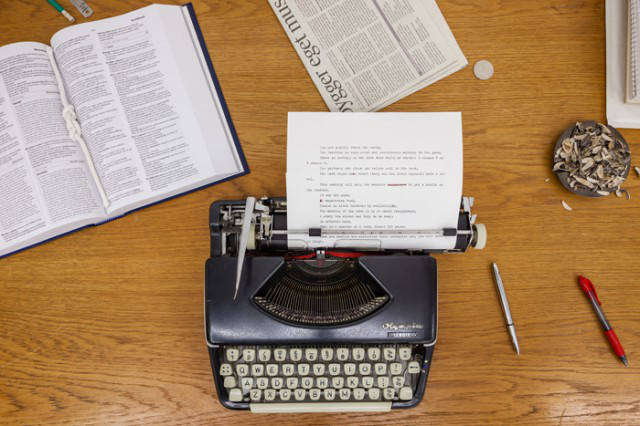 |
| Meriç Algün Ringborg, A Work of Fiction, 2013. Image: Galerie Nordenhake. |
Istanbul-born, Stockholm-based Meriç Algün Ringborg’s first solo show in her adopted city comprises three complementary components or approaches to displaying her eponymous ‘work of fiction’. First among them is an environment resembling the studio or workspace of some writer or creative type, displaying objects that may or may not provoke or comfort the imagination during production: a sculpted hand and head, commonplace reference books for a writer-in-the-making and some modernist furniture pieces that might be associated with a studio or office space. Second is the audio narrative Metatext (all works 2013), wherein a writerly voice dissects her intricate rapport with the act of writing. Here one hears observations on pursuing the craft, such as, “The first sentence is so hard to compose” or, “I was toying with the idea of writing a book”.
The third aspect: unbound pages, fitted neatly into a box (which one can open to sift through), from the manscript of a novel that refuses to fit any genre, although it highlights clichés found within already existing ones. The writing, A Work of Fiction, appears collected rather than deliberately written so as to follow any predictable, linear narrative arc. The text resides in the overlapping spheres between crime thriller, trite romance and realistic drama; the lives of three characters (Maria, Peter and Mark) unfold as one reads each dense, 500–1,000-word ‘flash fiction’-style narrative, and a question of authorship arises as one progresses further into the manuscript. Typed pages including typos are displayed, reminiscent of the once visceral, intimate nature of writing – when one expressed oneself with the assistance of a seemingly archaic machine, instead of the word processors used today.
The Oulipo movement, which Algün Ringborg acknowledges as an influence on this show, is predicated on applying constraints to literary production. Originating in France at the outset of the 1960s thanks to the collaborative energies of mathematicians and writers, it is now well established, and its influence still prevails in other parts of the world (eg, Los Angeles, in CalArts and the experimental writing movement in the area). Some critics argue that Oulipo has been exhausted, to the point that its ideas are no longer lucrative inspiration for others following the movement and in the midst of developing their creative practice – whether it be writing-based or otherwise. Others simply desire to see artists taking risks and not follow-ing any predesigned code or safe, trend-driven methodology. And some believe that Oulipo allows artists to dodge actual ‘productivity’, because some of its incorporated rules justify a questionably laissez-faire or inconclusive attitude, promoting thoughtless artmaking and writing. The poetic ‘flarf’ phenomenon, using text scoured from the Internet as a source of textual formulation, has been linked to Oulipo and harshly deemed subpar.
Now, and significantly for Algün Ringborg’s propositions (eg, a work here consisting of sentences appropriated from The Oxford English Dictionary and displayed via an overhead projector), others in Scandinavia (and elsewhere) are also working according to constraints – yet they often seem unaware that they are doing so. Some artists operate by following self-designed rules, others by adopting the rules of others, and some fall into a comfortable zone of using rules when unorganised, open-ended chaos seems too much for them to continue their path. This exhibition, then, could be perceived as a flippant mockery – or an invitation to alter one’s perspective on validity. It’s notable, in this questioning regard, that also on view here is a black-and-white faux bookshelf – the spines of books printed onto a plastic surface – displaying self-help volumes geared towards assisting a struggling writer searching for a guiding light. Such self-reflection and scrutiny are valuable for any artist who cares about how her own art is inevitably influenced by the practice and ideas of others, since the burdensome beast of crowd behaviour frequently leads to either acceptance or rejection in the art and publishing worlds alike.
To see the review in context, click here.








